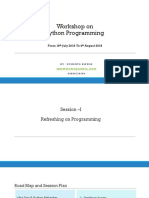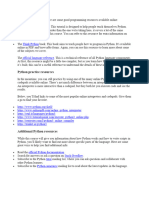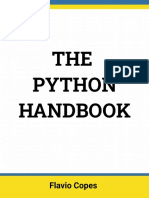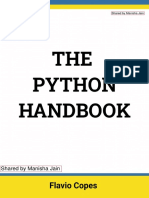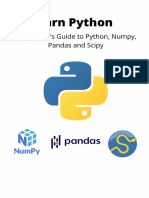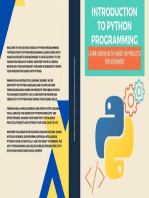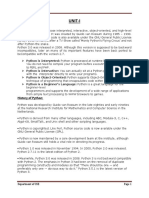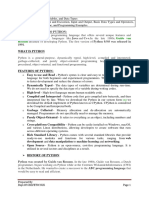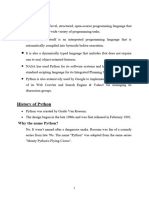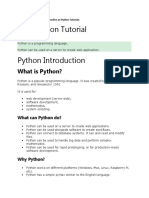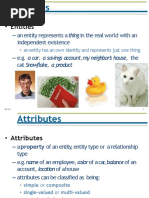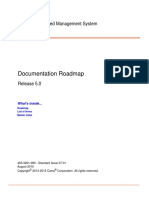4.3 Using The Python Command Prompt
4.3 Using The Python Command Prompt
Uploaded by
manasCopyright:
Available Formats
4.3 Using The Python Command Prompt
4.3 Using The Python Command Prompt
Uploaded by
manasOriginal Title
Copyright
Available Formats
Share this document
Did you find this document useful?
Is this content inappropriate?
Copyright:
Available Formats
4.3 Using The Python Command Prompt
4.3 Using The Python Command Prompt
Uploaded by
manasCopyright:
Available Formats
CHAPTER 4.
THE PYTHON INTERPRETER 32
will need to know the “old school” way of Python programming; many
open-source programs are still written for Python 2.4.
If you are using Python 3.x and you want to type every example
into your computer as we go along, please be aware that the print
statements, as written, won’t work. They will have to be modified to
use a print() function like in Listing 4.3.
4.3 Using the Python Command Prompt
If you write a statement that doesn’t require any “processing” by
Python, it will simply return you to the prompt, awaiting your next or-
der. The next code example shows the user assigning the value “spam”
to the variable can. Python doesn’t have to do anything with this, in
regards to calculations or anything, so it accepts the statement and
then waits for a new statement.
Listing 4.4: Python statements
>>>can = "spam"
>>>
(By the way, Python was named after Monty Python, not the
snake. Hence, much of the code you’ll find on the Internet, tutorials,
and books will have references to Monty Python sketches.)
The standard Python interpreter can be used to test ideas before
you put them in your code. This is a good way to hash out the
logic required to make a particular function work correctly or see how
a conditional loop will work. You can also use the interpreter as a
simple calculator. This may sound geeky, but I often launch a Python
session for use as a calculator because it’s often faster than clicking
through Windows’ menus to use its calculator.
Here’s an example of the “calculator” capabilities:
Listing 4.5: Python as a calculator
>>>2+2
4
>>>4∗4
16
>>>5∗∗2 #f i v e s q u a r e d
CHAPTER 4. THE PYTHON INTERPRETER 33
25
Python also has a math library that you can import to do trigono-
metric functions and many other higher math calculations. Importing
libraries will be covered later in this book.
4.4 Commenting Python
One final thing to discuss is that comments in Python are marked
with the “#” symbol. Comments are used to annotate notes or other
information without having Python try to perform an operation on
them. For example,
Listing 4.6: Python comments
>>>d i c t = { " F i r s t p h o n e t i c " : " Able " , " Second
p h o n e t i c " : " Baker " } #c r e a t e a d i c t i o n a r y
>>>print d i c t . k e y s ( ) #d i c t i o n a r y v a l u e s aren ’ t
in order
[ ’ Second p h o n e t i c ’ , ’ F i r s t p h o n e t i c ’ ]
>>>print d i c t [ " F i r s t p h o n e t i c " ] #p r i n t t h e key ’ s
value
Able
You will see later on that, even though Python is a very readable
language, it still helps to put comments in your code. Sometimes it’s to
explicitly state what the code is doing, to explain a neat shortcut you
used, or to simply remind yourself of something while you’re coding,
like a “todo” list.
4.5 Launching Python programs
If you want to run a Python program, simply type python at the shell
command prompt (not the IDE or interactive interpreter) followed by
the program name.
Listing 4.7: Launching a Python program
$python f o o . py
CHAPTER 4. THE PYTHON INTERPRETER 34
Files saved with the .py extension are called modules and can be
called individually at the command line or within a program, similar
to header files in other languages. If your program is going to import
other modules, you will need to make sure they are all saved in the
same directory on the computer. More information on working with
modules can be found later in this book or in the Python documenta-
tion.
Depending on the program, certain arguments can be added to the
command line when launching the program. This is similar to adding
switches to a Windows DOS prompt command. The arguments tell
the program what exactly it should do. For example, perhaps you
have a Python program that can output it’s processed data to a file
rather than to the screen. To invoke this function in the program you
simply launch the program like so:
Listing 4.8: Launching a Python program with arguments
$python f o o . py −f
The “-f” argument is received by the program and calls a function
that prints the data to a designated location within the computer’s
file system instead of printing it to the screen.
If you have multiple versions of Python installed on your computer,
e.g. the system default is version 2.5 but you want to play around
with Python 3.x, you simply have to tell the OS which version to
use (see Listing 4.9). This is important since many older Python
programs aren’t immediately compatible with Python 3.x. In many
cases, an older version of Python must be retained on a computer to
enable certain programs to run correctly; you don’t want to completely
overwrite older Python versions.
Listing 4.9: Selecting a Python version
$python2 . 5 sample . py #f o r c e use o f Python 2 . 5
$python3 . 0 sample . py #f o r c e use o f Python 3 . 0
4.6 Integrated Development Environments
I should take the time now to explain more about programming envi-
ronments. Throughout this book, most of the examples involve using
CHAPTER 4. THE PYTHON INTERPRETER 35
the Python interactive interpreter, which is used by typing “python” at
the operating system command prompt. This environment is is really
more for testing ideas or simple “one-shot” tasks. Because the infor-
mation isn’t stored anywhere, when the Python session is finished, all
the data you worked with goes away.
To make a reusable program, you need to use some sort of source
code editor. These editors can be an actual programming environ-
ment application, a.k.a. IDEs (integrated development environments),
or they can be a simple text editor like Windows Notepad. There is
nothing special about source code; regardless of the programming lan-
guage, it is simply text. IDEs are basically enhanced text editors that
provide special tools to make programming easier and quicker.
Python has many IDEs available and nearly all of them are free.
Typically, an IDE includes a source code editor, a debugger, a com-
piler (not necessary for Python), and often a graphical user interface
builder; different IDEs may include or remove certain features. Below
is a list of some common Python IDEs:
• Eric-a free application that acts as a front-end to other programs
and uses plug-ins
• IDLE-a free application included in the base Python installation;
includes an integrated debugger
• Komodo-a full-featured, proprietary application that can be used
for other programming languages
• PyDev-a plug-in for the Eclipse development environment
• Stani’s Python Editor (SPE)-a free application that includes
many development aids
Chapter 5
Types and Operators
Python is based on the C programming language and is written in C,
so much of the format Python uses will be familiar to C and C++
programmers. However, it makes life a little easier because it’s not
made to be a low-level language (it’s difficult to interact heavily with
hardware or perform memory allocation) and it has built-in "garbage
collection" (it tracks references to objects and automatically removes
objects from memory when they are no longer referenced), which al-
lows the programmer to worry more about how the program will work
rather than dealing with the computer.
5.1 Python Syntax
5.1.1 Indentation
Python forces the user to program in a structured format. Code blocks
are determined by the amount of indentation used. As you’ll recall
from the Comparison of Programming Languages chapter, brackets
and semicolons were used to show code grouping or end-of-line termi-
nation for the other languages. Python doesn’t require those; inden-
tation is used to signify where each code block starts and ends. Here
is an example (line numbers are added for clarification):
36
You might also like
- Python W3 SchoolDocument216 pagesPython W3 Schoolds0909@gmail90% (10)
- Hotel InventoryDocument11 pagesHotel InventorybbNo ratings yet
- Manual PhytonDocument115 pagesManual PhytonAndre100% (3)
- PythonDocument111 pagesPythonMonalisa Chatterjee100% (3)
- Async JavaScript and HTTP Requests - Learn JavaScript - Requests Cheatsheet - CodecademyDocument4 pagesAsync JavaScript and HTTP Requests - Learn JavaScript - Requests Cheatsheet - CodecademyChristopher SalimNo ratings yet
- DEF STAN 00 60 Part 0 I5Document34 pagesDEF STAN 00 60 Part 0 I5mjplNo ratings yet
- Python 2.0Document8 pagesPython 2.0Anoosha AnwarNo ratings yet
- Introduction To Python PDFDocument7 pagesIntroduction To Python PDFnabeel najjarNo ratings yet
- Python HandbookDocument115 pagesPython Handbookfbsrosa100% (1)
- PYTHON FOR BEGINNERS: Master the Basics of Python Programming and Start Writing Your Own Code in No Time (2023 Guide for Beginners)From EverandPYTHON FOR BEGINNERS: Master the Basics of Python Programming and Start Writing Your Own Code in No Time (2023 Guide for Beginners)No ratings yet
- PYTHON FOR BEGINNERS: A Comprehensive Guide to Learning Python Programming from Scratch (2023)From EverandPYTHON FOR BEGINNERS: A Comprehensive Guide to Learning Python Programming from Scratch (2023)No ratings yet
- Python Notes 2Document18 pagesPython Notes 2Alkxm NbsNo ratings yet
- Python NotesDocument6 pagesPython Notesaknumsn7724No ratings yet
- How To Program PythonDocument26 pagesHow To Program Pythonlalo_blood100% (1)
- Python HandbookDocument115 pagesPython HandbookSudip Mutha100% (6)
- Python Course SyllabusDocument7 pagesPython Course Syllabusarunraja98No ratings yet
- Python Programming.Document145 pagesPython Programming.ramksamy2024No ratings yet
- 01-b - PythonDocument23 pages01-b - PythonOmar AJNo ratings yet
- TextDocument6 pagesTextkm7919640No ratings yet
- Python Notes Unit 1 and 2Document46 pagesPython Notes Unit 1 and 2ShitanNo ratings yet
- Python for Beginners: An Introduction to Learn Python Programming with Tutorials and Hands-On ExamplesFrom EverandPython for Beginners: An Introduction to Learn Python Programming with Tutorials and Hands-On ExamplesRating: 4 out of 5 stars4/5 (2)
- The Python Tutorial: Saciando Tu ApetitoDocument114 pagesThe Python Tutorial: Saciando Tu Apetitotvboxsmart newNo ratings yet
- Lab 1 PythonDocument17 pagesLab 1 PythonTegbaru TameneNo ratings yet
- Part 2Document7 pagesPart 2hassanzozNo ratings yet
- OneCampus - Python Programming TextbookDocument263 pagesOneCampus - Python Programming TextbookmuheezadedejiokunadeNo ratings yet
- Python ProgrammingDocument150 pagesPython Programmingavufello100% (1)
- Kumar, Kishore - Learn Python - A Beginner's Guide To Python, Numpy, Pandas and Scipy (2021)Document348 pagesKumar, Kishore - Learn Python - A Beginner's Guide To Python, Numpy, Pandas and Scipy (2021)Daniel GNo ratings yet
- Python Programming: Your Beginner’s Guide To Easily Learn Python in 7 DaysFrom EverandPython Programming: Your Beginner’s Guide To Easily Learn Python in 7 DaysRating: 2.5 out of 5 stars2.5/5 (3)
- Lxmls - Lab Guide: July 19, 2015Document115 pagesLxmls - Lab Guide: July 19, 2015ricksant2003No ratings yet
- PP Unit I Notes Dbatu-1Document20 pagesPP Unit I Notes Dbatu-1Viresh TambakeNo ratings yet
- PDF Advanced Programming ModuleDocument50 pagesPDF Advanced Programming ModuleShrutiNo ratings yet
- Python ProgrammingDocument89 pagesPython Programmingapi-26155224No ratings yet
- Python From Zero To HeroDocument94 pagesPython From Zero To HeroNichervan EssaNo ratings yet
- Unit 1Document28 pagesUnit 1racaf53971No ratings yet
- Learn Python Programming The Comprehensive Guide To Learn and Apply Python by Learning Coding 2021Document81 pagesLearn Python Programming The Comprehensive Guide To Learn and Apply Python by Learning Coding 2021Percyes_Civilunh100% (3)
- Python Programming For Beginners: Python Programming Language TutorialFrom EverandPython Programming For Beginners: Python Programming Language TutorialNo ratings yet
- Python Software NotesDocument31 pagesPython Software Notesshanthigaddam2003No ratings yet
- Module 1 Introduction To Python Programming: Information and Communication TechnologyDocument18 pagesModule 1 Introduction To Python Programming: Information and Communication TechnologyFernando Lipardo Jr.No ratings yet
- Python w3schoolDocument511 pagesPython w3schoolromarickoutonsouNo ratings yet
- Bcaty Unit-1 Python Notes ModifiedDocument21 pagesBcaty Unit-1 Python Notes ModifiednmscompdeptNo ratings yet
- PythonDocument5 pagesPythongestNo ratings yet
- Introduction to Python Programming: Learn Coding with Hands-On Projects for BeginnersFrom EverandIntroduction to Python Programming: Learn Coding with Hands-On Projects for BeginnersNo ratings yet
- Python - Security101 - Blackhat Techniques - Hacking Tutorials - Vulnerability Research - Security ToolsDocument16 pagesPython - Security101 - Blackhat Techniques - Hacking Tutorials - Vulnerability Research - Security ToolsLuis Esteban RodríguezNo ratings yet
- Python Programming Lecture NotesDocument15 pagesPython Programming Lecture NotesMahesh MarupakulaNo ratings yet
- Unit IIDocument63 pagesUnit IIBhargav MurkiNo ratings yet
- Python ProgrammingDocument120 pagesPython ProgrammingCharathNo ratings yet
- Python Language CompanionDocument133 pagesPython Language CompanionrahulNo ratings yet
- PLC Module-1Document33 pagesPLC Module-1Arvind RangdalNo ratings yet
- Software EnvironmentDocument27 pagesSoftware Environmento180363No ratings yet
- Python Programming: 8 Simple Steps to Learn Python Programming Language in 24 hours! Practical Python Programming for Beginners, Python Commands and Python LanguageFrom EverandPython Programming: 8 Simple Steps to Learn Python Programming Language in 24 hours! Practical Python Programming for Beginners, Python Commands and Python LanguageRating: 2 out of 5 stars2/5 (1)
- CSC1201 Python ProgrammingDocument33 pagesCSC1201 Python ProgrammingchizpsquareNo ratings yet
- Pytthon For Data Analysis From ScratchDocument37 pagesPytthon For Data Analysis From Scratchxwpom2100% (5)
- Python Notes Unit1Document62 pagesPython Notes Unit1ert345615No ratings yet
- The Python TutorialDocument180 pagesThe Python Tutorialjackmwexh1225No ratings yet
- Lesson 3 Introduction To PythonDocument4 pagesLesson 3 Introduction To Pythonflyware600No ratings yet
- Python 1&2Document129 pagesPython 1&2VedantGonnadeNo ratings yet
- Python 1Document19 pagesPython 1chiranjeevi devireddyNo ratings yet
- Lesson 9 Proramming Errors ToolsDocument21 pagesLesson 9 Proramming Errors Toolsweaverjordan210No ratings yet
- py3.8Document141 pagespy3.8Pandi SelviNo ratings yet
- Python PracticalsDocument33 pagesPython PracticalsShehbaz Hasware100% (2)
- My Lecture in W3school1Document185 pagesMy Lecture in W3school1Carlos PerezNo ratings yet
- 10.7 SerializationDocument4 pages10.7 SerializationmanasNo ratings yet
- Simple Selecting: Jquery: Novice To Ninja 22Document3 pagesSimple Selecting: Jquery: Novice To Ninja 22manasNo ratings yet
- 2.1.4 Procedural vs. Object-Oriented ProgrammingDocument3 pages2.1.4 Procedural vs. Object-Oriented ProgrammingmanasNo ratings yet
- Intelligent Transport SystemDocument1 pageIntelligent Transport SystemmanasNo ratings yet
- Geostatistical Methods in R: Adéla Volfová, Martin ŠmejkalDocument26 pagesGeostatistical Methods in R: Adéla Volfová, Martin ŠmejkalmanasNo ratings yet
- Chapter Two Literature ReveiwDocument9 pagesChapter Two Literature ReveiwHeitham OmarNo ratings yet
- 10 1 1 68 8932Document426 pages10 1 1 68 8932Martha ChávezNo ratings yet
- Conventional Software ManagementDocument21 pagesConventional Software ManagementSweeti Sah100% (1)
- The 4 Values and 12 Principles of The Agile ManifestoDocument6 pagesThe 4 Values and 12 Principles of The Agile ManifestoCosta VaggasNo ratings yet
- 02 EOS SpecDocument12 pages02 EOS Speckokono8018No ratings yet
- Case Study Tata SteelDocument3 pagesCase Study Tata SteelAnkurNo ratings yet
- 2016 UpdatedDocument2 pages2016 UpdatedParanthamanNo ratings yet
- Processing GNSS BaselinesDocument15 pagesProcessing GNSS BaselinesMESSAOUDINo ratings yet
- Bsi DraftDocument2 pagesBsi DraftkoushkiNo ratings yet
- Offline Visualizer Scenes Martin LightJockeyDocument332 pagesOffline Visualizer Scenes Martin LightJockeyRodion ChesovNo ratings yet
- CV Akbar PutraDocument5 pagesCV Akbar PutradenyNo ratings yet
- Serving The World: Innovative Products & Solutions From MalaysiaDocument28 pagesServing The World: Innovative Products & Solutions From MalaysiaSuresh KumarNo ratings yet
- Siemens - IoT in Power Grids - White PaperDocument12 pagesSiemens - IoT in Power Grids - White PaperPaola RodriguesNo ratings yet
- Detection of Frauds For Debit Card Transactions atDocument10 pagesDetection of Frauds For Debit Card Transactions atAhmad FaisalNo ratings yet
- Bluetooth Audio Digital Signal Processing An ArduiDocument10 pagesBluetooth Audio Digital Signal Processing An ArduiLanah Krizten AsperoNo ratings yet
- Erd 2Document18 pagesErd 2Bilal AliNo ratings yet
- Dse8810 Data Sheet (Usa)Document2 pagesDse8810 Data Sheet (Usa)Kelian BonnotNo ratings yet
- SAP EWM PPF For Auto Post Goods Issue (PGI)Document4 pagesSAP EWM PPF For Auto Post Goods Issue (PGI)karinbeve1No ratings yet
- Digital Image Correlation and Tracking With MatlabDocument46 pagesDigital Image Correlation and Tracking With MatlabUmer WaheedNo ratings yet
- Social Media ApplicationsDocument3 pagesSocial Media ApplicationsDua EimanNo ratings yet
- KPI Investigation Methodology ProcessDocument27 pagesKPI Investigation Methodology ProcessAbraham KraNo ratings yet
- React-Native Code TestDocument8 pagesReact-Native Code TestYayan ArthaNo ratings yet
- Changes in Cmmi 2.0 and How They Can Affect TmmiDocument21 pagesChanges in Cmmi 2.0 and How They Can Affect TmmiamitNo ratings yet
- M95 AT Commands Manual V1.2 PDFDocument241 pagesM95 AT Commands Manual V1.2 PDFjuanNo ratings yet
- 450-3201-090 (OneControl R5.0 Documentation Roadmap) 07.01Document116 pages450-3201-090 (OneControl R5.0 Documentation Roadmap) 07.01surendra singhNo ratings yet
- A Comprehensive Analysis of The Role of Artificial Intelligence and Machine Learning in Modern Digital Forensics and Incident ResponseDocument30 pagesA Comprehensive Analysis of The Role of Artificial Intelligence and Machine Learning in Modern Digital Forensics and Incident ResponseSaef MomaniNo ratings yet
- CD LexProgramDocument11 pagesCD LexProgramvetrikumar6380268095No ratings yet




